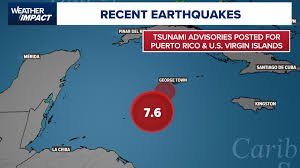
Tsunami Alerts Cancelled After Caribbean Earthquake
A powerful 7.6-magnitude earthquake struck the Caribbean Sea on Saturday evening, sending shockwaves across the region and triggering tsunami warnings. However, these alerts were later cancelled after the threat of dangerous waves subsided, according to the United States Geological Survey (USGS).
The earthquake, which occurred about 20 miles (32.1 kilometers) north of Honduras and approximately 130 miles (209.2 kilometers) southwest of the Cayman Islands, was felt across several countries. In response, the US Tsunami Warning System issued alerts for over a dozen nations, warning of possible waves up to 3 meters (10 feet) high. However, these warnings were soon lifted as the risk of a tsunami diminished.
Advisories were also issued for Puerto Rico and the Virgin Islands following the quake, but these too were rescinded as the situation calmed. The Cayman Islands government, in a precautionary move, advised residents of coastal areas to relocate inland as a safety measure.
While the tsunami threat was cancelled, it remains unclear whether there was any significant damage on land or if there were reports of injuries. The earthquake’s epicenter, situated in a relatively remote part of the Caribbean Sea, reduced the likelihood of widespread destruction due to the absence of major population centers in the immediate vicinity.
This earthquake is the largest to hit the region since a 7.2-magnitude earthquake struck Haiti in 2021, according to the US National Oceanic and Atmospheric Administration (NOAA). The USGS noted that large earthquakes along this particular plate boundary are not unexpected. In fact, a 7.5-magnitude earthquake occurred in the region in 2018, causing some damage and triggering a small tsunami.
About three hours after the earthquake, the US authorities warned of potential “minor sea level fluctuations” of up to 30 cm (11.8 inches), but clarified that there was no serious tsunami threat. The situation was continuously monitored, and the warnings were gradually scaled down as further information was received.
The US National Tsunami Warning Centre also confirmed that there were no alerts in effect for the US mainland coast, meaning the earthquake did not pose a risk to the continental United States.
Experts explained that the location of the earthquake, along a plate boundary, makes such seismic events relatively common in this region, though the remote location of this particular earthquake helped mitigate its potential impact. In areas closer to the epicenter, the relatively low population density also helped limit the risk of major damage from the shaking.
The USGS emphasized that while large earthquakes in this part of the Caribbean are not unusual, the quick cancellation of the tsunami warnings was a positive outcome. The authorities continue to monitor the area for any aftershocks or additional seismic activity.
This earthquake serves as a reminder of the unpredictable nature of natural disasters, particularly in regions situated near active tectonic boundaries. Authorities continue to remain vigilant in monitoring and responding to seismic events to protect the safety of residents and minimize potential hazards.